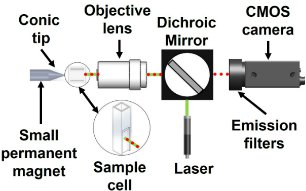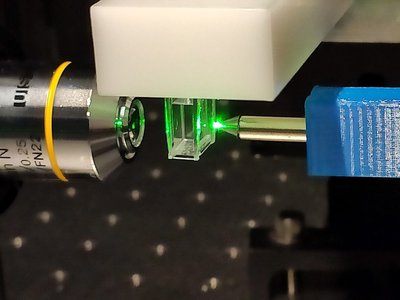MAGNETICALLY AGGREGATED BIOSENSING (MAB) SYSTEM
Detection of biomarkers at low concentrations is essential for early diagnosis of numerous diseases. In many sensitive assays, the target molecules are tagged using fluorescently labeled probes and captured using magnetic beads. Magnetic beads facilitate washing and separation steps, are well suited for automation, and improve the assay sensitivity. Current devices rely on quantifying the target molecules by detecting the fluorescence signal from individual beads. Thus, to detect low concentrations of target molecules, these devices require sophisticated optical detectors, making them bulky and expensive.
We have built, in our lab, a compact fluorescence-based system that simply uses a small permanent magnet with a conic tip to aggregate the magnetic beads, forming a cluster of fluorescently labeled probes whose fluorescence signal is much greater than that of a single bead.
 Using the magnetically aggregated biosensors to detect human Interleukin-8, we demonstrated a limit of detection of 0.1 ng/l and a 4-log dynamic range performance, which is on par with the most sensitive devices but is achieved without their bulk and cost.
Using the magnetically aggregated biosensors to detect human Interleukin-8, we demonstrated a limit of detection of 0.1 ng/l and a 4-log dynamic range performance, which is on par with the most sensitive devices but is achieved without their bulk and cost.
In September 6th, 2019, our paper on detection of low concentrations of biomarkers using fluorescent-based, magnetically aggregated biosensors (MAB) system was published at Applied Physics Letters - "APL".
The paper, entitled 'Magnetically aggregated biosensors for sensitive detection of biomarkers at low concentrations', can be found in the Publications section, and at DOI: 10.1063/1.5108891


